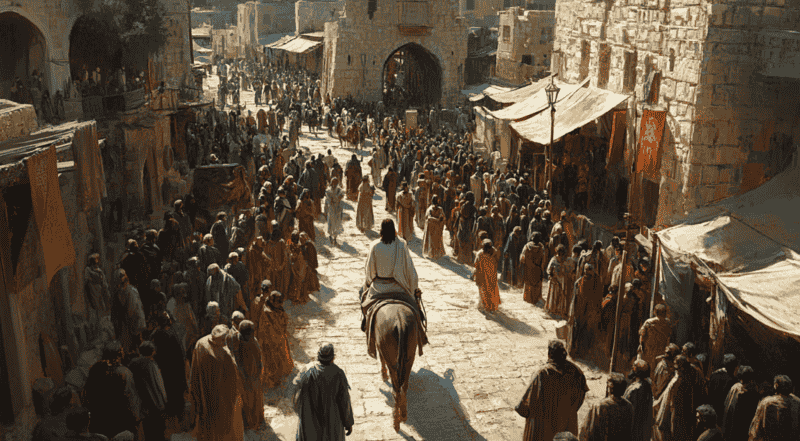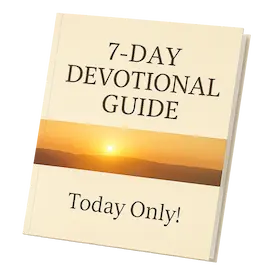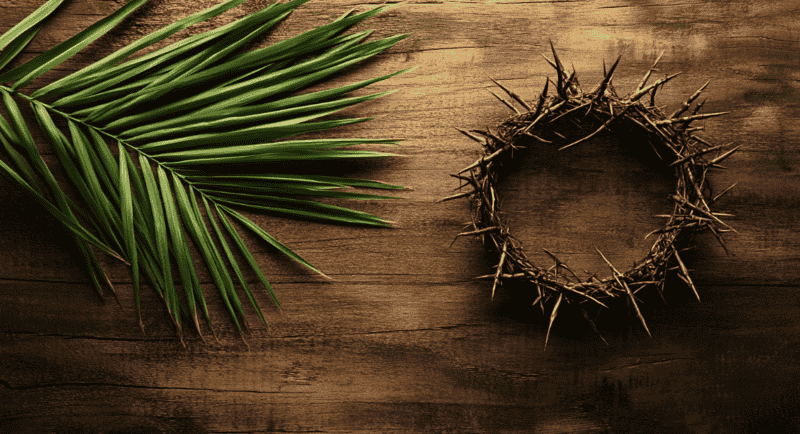The Triumphal Entry into Jerusalem
Jerusalem was never quiet, but during Passover, it was something else entirely. The city swelled with pilgrims from all over, filling the streets with voices, the smell of roasting lamb, and the restless energy of a people living under Roman rule. The tension was always there: talk of rebellion, whispers of prophecy, a deep longing for deliverance.
And then came Jesus.
He didn’t arrive like a revolutionary, though He had the following of one. He didn’t storm the gates like a king reclaiming His throne, though the people greeted Him as if He would. Instead, He rode in on a donkey (a borrowed one, at that).
This wasn’t a random choice. It was deliberate. Centuries earlier, the prophet Zechariah had written:
“Rejoice greatly, O daughter of Zion! Shout aloud, O daughter of Jerusalem! Behold, your king is coming to you; righteous and having salvation is he, humble and mounted on a donkey, on a colt, the foal of a donkey.” (Zechariah 9:9)
This was the Messiah’s entrance. Not as a warrior on a warhorse, but as a King of peace. He wasn’t here to overthrow Rome. He was here to do something much bigger.
The crowd didn’t fully understand. They shouted Hosanna!—a word that meant Save us now! They laid their cloaks and palm branches before Him, an ancient sign of honor and victory (2 Kings 9:13). To them, this was the beginning of something huge. The long-awaited moment when God’s chosen one would finally break their chains.
And yet, Jesus knew what was coming. He saw past the palm branches, past the adoring crowd. In just a few days, the same voices crying Hosanna would be screaming Crucify Him! He knew He was riding toward betrayal, rejection, and death.
Still, He kept going.
Fulfillment of Prophecy: The Significance of Palm Sunday
Everything about Palm Sunday was intentional. Jesus wasn’t caught up in a spontaneous celebration. He was fulfilling a script written long before the foundations of the world. Every detail echoed prophecy, yet most of the crowd didn’t see it.
Zechariah had foretold it:
“Behold, your king is coming to you; righteous and having salvation is he, humble and mounted on a donkey.” (Zechariah 9:9)
A king riding a donkey was a statement. In ancient times, kings rode warhorses when they came to conquer. A donkey was a symbol of peace. Jesus wasn’t here to wage war against Rome. He was here to bring peace between God and man.
And yet, the people still expected something else. They had waited for a Messiah who would break the oppressor’s yoke, who would restore Israel’s political power. They thought Jesus was about to claim the throne. Instead, He was heading toward a cross.
Even the crowd’s shouts carried layers of meaning they didn’t fully grasp. When they cried Hosanna! and quoted Psalm 118—
“Blessed is he who comes in the name of the Lord!” (Psalm 118:26)
They were reciting a psalm traditionally sung during Jewish festivals, particularly as a victory cry. But Psalm 118 also includes these words:
“The stone that the builders rejected has become the cornerstone.” (Psalm 118:22)
Jesus was that stone. They were welcoming Him as King, but in a matter of days, they would reject Him completely.
Even the location of His arrival was significant. The Mount of Olives, where Jesus began His descent into Jerusalem, was linked to messianic prophecy (Zechariah 14:4). The stage was set, the signs were clear, and the prophecies were unfolding in real time.
Yet, despite all of this, most people missed the real story. They saw a potential leader. They didn’t see the Lamb of God who was about to be sacrificed for the sins of the world.
Jesus wasn’t just stepping into history. He was fulfilling it.
Get Closer to God Today
4.9
Average Rating
|Over 5 Million Downloads
The Palm Branches: Symbols of a Misunderstood Victory
For the people in Jerusalem that day, waving palm branches wasn’t just an act of celebration. Palms had a history. They were a symbol of victory, power, and national pride.
A century earlier, when the Jewish Maccabees had successfully rebelled against Greek rule, the people celebrated by waving palm branches. They even stamped them on their coins as a sign of independence.
But Jesus wasn’t coming to liberate them from Rome. He was coming to liberate them from sin and death. His kingdom wasn’t about political power, it was something much bigger. But the people wanted a Messiah on their terms. They were ready to embrace Jesus as long as He fit their expectations.
The irony is that the palm branch, a symbol of victory, ended up foreshadowing something else. Less than a week later, Jesus would stand before a Roman governor, beaten and bloodied, with a different kind of plant forced onto His head—a crown of thorns.

The Acclamation of 'Hosanna': Palm Sunday Meaning
The word Hosanna filled the streets as Jesus rode into Jerusalem. Hosanna comes from Hebrew, meaning “Save us now!” I
When they shouted:
“Hosanna to the Son of David! Blessed is he who comes in the name of the Lord!” (Matthew 21:9, quoting Psalm 118:25-26)
They were invoking the Messianic hope that God’s anointed one would restore Israel’s kingdom. They believed Jesus was that King. And He was. But they misunderstood what His reign would look like.
The same people crying Hosanna on Sunday would be shouting Crucify Him by Friday. How does a crowd turn so fast?
Because Jesus didn’t meet their expectations. He didn’t storm the palace. He didn’t lead an uprising. Instead, He spoke about things like humility, servanthood, and a kingdom not of this world (John 18:36). Instead of overthrowing the Romans, He overturned tables in the temple. Instead of confronting their enemies, He confronted their sins.
And when they realized He wasn’t the kind of Messiah they wanted, they rejected Him.
And so He kept riding. Not to a throne, but to a cross. Not to war, but to sacrifice. Because real salvation was coming. Just not in the way anyone expected.
The Path to the Cross Begins Here

Palm Sunday looked like the beginning of something victorious. In reality, it was the first step toward betrayal, suffering, and death.
Jesus knew it. As the crowd cheered, He was looking ahead. Ahead to the Last Supper, where one of His closest friends would betray Him. Ahead to Gethsemane, where He would sweat drops of blood, pleading with the Father. Ahead to the trials, the mocking, the flogging, and ultimately, the cross.
Luke records a striking moment right in the middle of the celebration:
“And when he drew near and saw the city, he wept over it, saying, ‘Would that you, even you, had known on this day the things that make for peace! But now they are hidden from your eyes.’” (Luke 19:41-42)
While everyone else was celebrating, Jesus was crying. Because He knew that despite all the shouts of Hosanna, they didn’t understand what was happening.
And so, within days, the same people who cheered for Him would turn on Him. The ones who laid their cloaks on the ground would strip Him of His. The voices crying Hosanna would soon be yelling Crucify Him.
Jesus didn’t flinch. He kept walking the path set before Him. Because Palm Sunday wasn’t just a moment of joy. It was the beginning of the greatest act of love the world would ever see.
The Unraveling Begins: A Palm Sunday Story
Jesus had His own mission, and it didn’t look anything like what they had in mind. Instead of heading to the palace, He went straight to the temple. He flipped tables, drove out the money changers, and called out the corruption that had turned a house of prayer into a “den of robbers” (Matthew 21:13).
The religious leaders ran the temple like a business, and Jesus was wrecking their system. The Pharisees and Sadducees saw the writing on the wall. If this man hadn’t stopped, everything would change.
And so the unraveling began. The moment Palm Sunday ended, the plot to kill Jesus gained momentum. He wasn’t the kind of Messiah they wanted, and for that, He had to go.
Palm Sunday’s Inevitable Paradox
The people wanted a revolution. Jesus was giving them a reckoning and was a collision course.. The cheers of Palm Sunday wouldn’t last, because Jesus wasn’t here to meet expectations. The road He was walking didn’t lead to a throne in Jerusalem. It led to Golgotha.
The people thought they were witnessing the rise of a king. In reality, they were witnessing the beginning of the greatest act of love the world would ever see. Because the funeral march of Palm Sunday would end in resurrection.
Get Closer to God Today
4.9
Average Rating
|Over 5 Million Downloads





